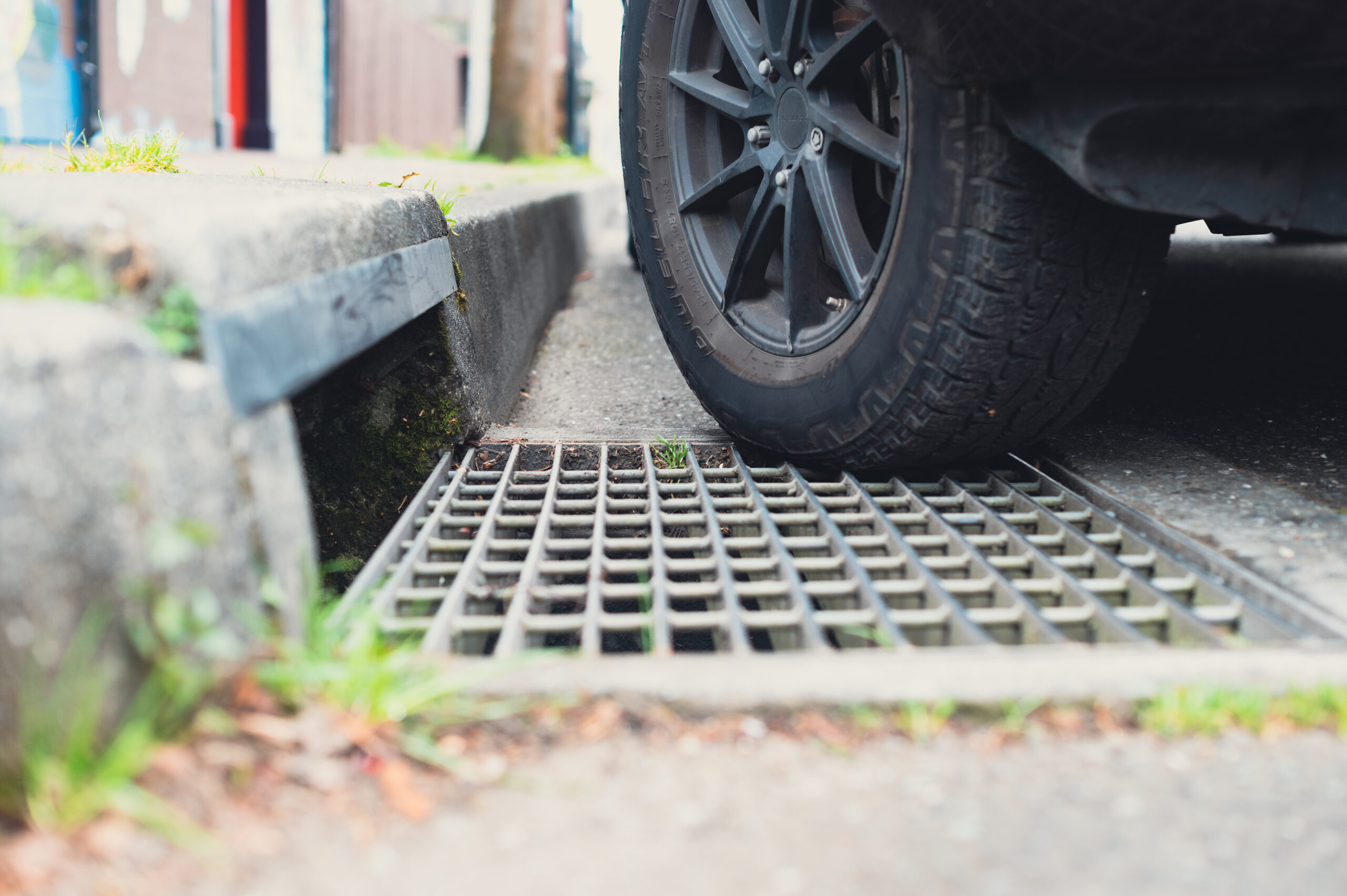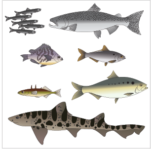
West Coast salmon and steelhead populations have declined steeply in the past century – a plight that biologists have primarily blamed on habitat loss. Dams, for instance, block adult fish’s access to historic spawning grounds, and juvenile survival is impacted by streamside development and water diversions.
Now, it turns out, microplastic pollution may be a much bigger factor than anyone knew just several years ago.
In 2019, scientists with the San Francisco Estuary Institute and the Los Angeles-based nonprofit 5 Gyres published findings indicating that car tire particles are one of the most prevalent forms of microplastic pollution flowing into San Francisco Bay. Then, in 2020, a team of West Coast scientists discovered that a chemical in these particles is extremely toxic to coho salmon at miniscule concentrations, apparently responsible for abrupt die-offs of adult fish observed over many years in Puget Sound streams. The researchers published their results in the journal Science.
“The hard part was that our instruments identified more than 2,000 chemicals in the mixture that could have been causing the mortality,” says Ed Kolodziej, a chemist at the University of Washington and a lead investigator on the research.
Through many trials and mass spectrometer runs, they isolated 6PPD-quinone as the primary causal toxicant that was killing coho salmon in urban and suburban streams. The molecule is a transformation product of a manufactured chemical parent, 6PPD, an antioxidant used globally to protect tire rubber from exposure to ambient ozone gas, which can cause rapid rubber breakdown.
6PPD-q is extremely toxic to coho, lethal at minute concentrations. Jen McIntyre, a Washington State University fish biologist and aquatic toxicologist who collaborated with Kolodziej, says concentrations as low as about 65 nanograms per liter of 6PPD-q — think two or three drops of water in an Olympic-size swimming pool — killed coho salmon within hours of exposure in laboratory tanks.
The scientists observed that exposure to the chemical was followed quickly by a breach in the cohos’ blood-brain barrier — what they call vascular leaking and which can allow foreign chemicals to enter the brain. That, McIntyre says, is as close as the scientists have gotten to identifying the exact cause of death for the fish. “We don’t know if 6PPD-q is entering the breach or if something else is getting in [and killing the salmon],” she explains.
One striking aspect of the findings, McIntyre says, is that roughly one coho in 30 was more or less unphased by 6PPD-q: individuals that the scientists dubbed “super-coho.”
Beyond coho, other salmonid species seem more tolerant of exposure to tire leachate and stormwater. In lab testing, McIntyre says, the same exposure rates that quickly killed coho did not cause death in chum and sockeye salmon. In steelhead and Chinook, some of the fish died after exposure. Some of these findings are yet to be published.
But fish that survive exposure to 6PPD-q, McIntyre points out, don’t necessarily swim away unharmed. “There could be sublethal effects that aren’t as obvious as sudden death,” she says.
The toxicity of the tire preservative in Pacific Northwest coho raises the question of whether fish species elsewhere may be similarly affected, and research is underway to find out. Scientists are tracking its presence and effects in the Great Lakes as well as waterways in Saskatchewan.
As for coho salmon, it’s a likely bet the fish are affected by 6PPD-q throughout their West Coast range, especially in the urbanized watersheds of the California coast. Here, coho salmon once spawned in most rivers and streams. The fish were abundant, with hundreds of thousands swimming inland each year to lay and fertilize their eggs. As late as the 1970s, coho salmon remained an important component of California’s commercial and recreational salmon landings. However, their numbers have since plunged, and the fish are endangered today — and extinct in many watersheds. Habitat loss, drought, and agricultural pollution have reduced their reproductive success. So has the diversion of water from streams for wine grapes and marijuana.
Now, it’s safe to reason that increasing runoff of toxic tire wear particles is at least partially responsible for the coho’s decline. Eroded tire particles are estimated to be the world’s most common form of microplastic pollution, with every American responsible, on average, for 7-12 pounds of the material every year. In the Bay Area’s bustling economy, where roadways host more traffic now than probably ever before, these figures translate into as much as 80 million pounds of vehicle tire waste annually released into the environment.
But until recently, tire particles were water under the bridge, essentially undetectable. “We’ve known for a long time that car tires wear down, but microplastics research studies were always looking at relatively large pieces of plastic,” says Kelly Moran, a senior scientist with SFEI who has led recent microplastic studies.
Tire wear particles are typically so small that they slip past conventional sampling sieves, and SFEI’s 2019 report outlined the first surveys in which scientists got a good look at this particular form of pollution in San Francisco Bay. To sample for tire wear particles, SFEI downsized from larger to smaller sieve sizes and, Moran says, sampled below the water surface. Each was a novel approach compared to past sampling programs, which have focused on surface water, since microfibers — another major form of microplastic — tend to float.
Their gritty findings were alarming. They found that tiny black particles, suspected to be rubber, constituted 48 percent of all microparticles flowing to the Bay.
One reason that tire particles are so toxic is their miniscule size, which creates proportionally more surface area relative to their mass. “[S]maller particles typically have greater total surface area per unit mass,” SFEI scientists explained in a 2021 report. This allows chemicals in the tire particles to more rapidly enter the surrounding water.
But the toxic preservative is not the only problem with tire wear particles, says Susanne Brander, an Oregon State University toxicologist and co-chair of a recent California Ocean Science Trust and Ocean Protection Council science advisory team on microplastics in marine ecosystems. “The tire particles themselves can be ingested and take up space in the gut and block nutrient uptake,” she says, adding that this is a problem associated with other microplastics.

And with ingestion of plastic, size matters. Big is bad because the particles can choke small creatures, but the smaller pieces, approximately 80 microns and smaller, Brander says, may offer their own insidious threat: movement from the gut into other tissues. This is called translocation, and it’s a growing problem as vast flotillas of plastic corrode into smaller and smaller pieces. This shrinkage process essentially never ends.
The flow of tire wear particles and other microplastics into the environment has so thoroughly polluted every ecosystem on the planet that future generations will never mitigate the mess they inherit. On the brighter side of the crisis, the overwhelming evidence that 6PPD-q causes almost instant death in coho salmon is driving regulatory action. The California Ocean Protection Council is now studying a path toward controlling microplastic pollution, with an eye specifically on tire wear particles. So is the California Department of Toxic Substances Control, which has started the process of officially listing motor vehicle tires as an environmental concern. Anne-Cooper Doherty, an environmental scientist with the department, says that in 2023 tire manufacturers must begin searching for a replacement chemical for tire production.
While that’s a good start, the process could take years and there’s no guarantee that the industry will come up with a safe and effective substitute. “They could come back and say there is no alternative,” Doherty says.
But the road would not end there. Novel filtering devices, already available and showing effectiveness in pilot studies, can be fitted behind the wheels of vehicles, where they capture most of a vehicle’s rubber emissions. Planting extensive rain gardens along roadways at key locations could also slow the migration of tire particles and leachate from roadways toward waterways. Moran suggests even simpler solutions: people might replace driving cars with taking transit, walking, and riding bicycles — and, for their cars, buy tires rated for longer life and more road miles.
Even without specifically sampling for 6PPD-q in waterways everywhere, Kolodziej says it’s “reasonable to assume it’s everywhere in the world that cars are.” He says research is now underway to understand the lifespan of this chemical and, once it’s loose in the environment, “if there might be some way to scrub it out.”
Top Photo: Lonny Meyer.
Previous Estuary News Stories
Links
A ubiquitous tire rubber–derived chemical induces acute mortality in coho salmon, Science
Understanding Microplastic Levels, Pathways & Transport in SF Bay Region, SFEI
Synthesis of Microplastics in Urban Runoff, SFEI
The Next Source of Trouble for Great Lakes Fish Populations: Tires – Circle of Blue
Study finds California salmon face deadly threat from car tires, Mercury News
